Jan-03-10
 | | chancho: Deliberately castling into a discovered check. Interesting. |
|
| Jan-03-10 | | zanshin: Pretty bold - still OK though:
White to play move 13, comparison of 0-0 and Kd2:
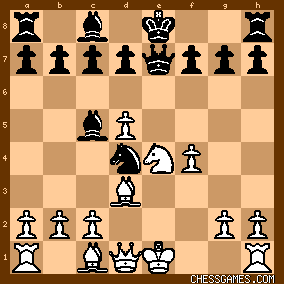
click for larger view [+1.00] d=16 13.Kd2 O–O 14.c3 Nf5 15.Re1 Be3 16.Kc2 Bxc1 17.Qxc1 Qh4 18.g4 Nd6 19.Nxd6 cxd6 20.f5 b6 21.Qf4 Bb7 (0:15.55) 33394kN [+0.56] d=15 13.O–O Nb3 14.Nf2 Bxf2 15.Rxf2 Nxc1 16.Rxc1 O–O 17.Qe2 Qc5 18.Re1 d6 19.Qe7 f5 20.c4 Qd4 21.Qe3 Qxe3 (0:07.07) 15124kN |
|
Jan-03-10
 | | Pawn and Two: On his 10th move, instead of (.00) (19 ply) 10...Nd4 11.Bd3, Gunsberg should have preferred 10...Ne7, which Fritz evaluates as leading to a small advantage for Black: (-.37) (19 ply) 10...Ne7 11.Bd2 0-0 12.Qf3 c6. Leopold Hoffer questioned 10...Nd4, and asked, <Why not 10...Bxc3+ 11.bxc3 Qxc3+ 12.Bd2 Qc5!, with good play?>. Fritz indicates Hoffer's line is very playable, giving a minimal edge to Black: (-.17) (21 ply) 13.Qe2+ Kd8 14.Qc4 Re8+ 15.Kf1 Qxc4+ 16.Bxc4 Ne7. After 10...Nd4 11.Bd3, Gunsberg could have maintained approximately equal chances with the following line: (.08) (20 ply) 11...Nf5 12.Bxf5 Qxf5 13.Qe2+ Kd8 14.Be3 Bxc3+ 15.bxc3 Qxd5 16.0-0 Re8. Instead of 11...Nf5, with approximately equal chances, Gunsberg moved his DSB for the fourth time, 11...Bc5?. As noted by <zanshin> and confirmed by Fritz, White could have gained a considerable advantage after 11...Bc5?12.Ne4 Qe7, (if 12...Qh4+ 13.g3 Qe7), by playing: (1.61) (20 ply) 13.Kd2! 0-0 14.c3 Nf5 15.Re1 Be3 16.Kc2 Bxc1, (1.68) (20 ply) 17.Qxc1 Qh4 18.g4 Nd6 19.Nxd6 cxd6 20.f5. Instead of 13.Kd2!, Marco played 13.0-0, which considerably reduced his advantage. Gunsberg's best reply to 13.0-0, was 13...Nb3+, instead, he played 13...Nxc2+?. After 13.0-0 Nxc2+?, White had strong winning chances: (1.55) (21 ply) 14.Nf2! Ne3 15.Bxe3 Bxe3 16.Re1 0-0 17.Bxh7+ Kxh7 18.Qd3+ Kg8 19.Rxe3, (2.85) (23 ply) 19...Qf6 20.Ne4 Qa6 21.Qc3 f5 22.Ng5 Qf6 23.Qxc7 Qb6 24.Qxb6 axb6 25.Rc3. Instead of playing 14.Nf2!, with strong winning chances, Marco erred with 14.Kh1?. After 14...Nxa1 15.Re1 Kd8, the position was approximately equal: (-.07) (24 ply) 16.d6 Bxd6 17.Ng5 Qf6. Instead of 16.d6, Marco played 16.Bd2?. Fritz indicates this position favors Black! 
click for larger view |
|
Jan-04-10
 | | Pawn and Two: Instead of 16.d6, with a near equal position, Marco erred with 16.Bd2?, giving the advantage to Black. After 16.Bd2?, Black is behind in development, but with his material advantage, Fritz indicates the position is in favor of Black: (-.86) (24 ply) 16...f6 17.Bc3 Qf8 18.Qh5 Be7 19.Rxa1 b6 20.Rd1 Qe8 21.Qh3. On his 16th move, Gunsberg played 16...Bd4??. The 5th move of his DSB, while his WSB remained on c8! The move 16...Bd4??, should have proved fatal to Black after 17.d6! Fritz indicates that White is clearly winning after 17.d6!: (4.38) (22 ply) 17...cxd6 18.Bb4 Qh4 19.Nxd6 Qf6 20.Qc1 Bb6 21.Qc4 Rf8 22.Rc1, or (4.26) (22 ply) 17...Qf8 18.dxc7+ Kxc7 19.Qa4 Bc5 20.Nxc5 Qxc5 21.Rc1 Qxc1 22.Bxc1 Re8 23.Qc4+ Kd8 24.Bd2. |
|
Jan-04-10
 | | Pawn and Two: After 18...Qe6, Hoffer noted, <The sharpest continuation was 19.Nxd6 and 20.Bc4.> Fritz confirms that 19.Nxd6 was White's strongest continuation: (5.08) (23 ply) 19.Nxd6 Qf6 20.Bc4 Rf8 21.Ne4 Qxf4 22.Bxf8. After 19.Qxa1 a5, Marco was also clearly winning. At move 20, Fritz preferred 20.Nxd6 axb4 21.Rxe6 fxe6 22.Nf7+ Ke7 23.Nxh8. However, Marco's continuation 20.Bxd6 Re8 21.Qc1 Bb6, was also very good. At move 22, White's position was winning:

click for larger viewFritz indicates the strongest continuation was: (3.53) (22 ply) 22.Bc4! Qxe4 23.Rxe4 Rxe4 24.Bxf7. After 22.Bc4!, White has an even greater advantage if Black tries: (4.78) (21 ply) 22...Qg6 23.Ng5 Re6 24.Nxe6+ dxe6 25.Bb5, or (7.39) (21 ply) 22...Qf5 23.Ng3 Rxe1 24.Qxe1 Qf6 25.Nf5, or (8.97) (21 ply) 22...Qg4 23.Bxf7 Re6 24.Qd2 h6 25.Bxe6. Instead of playing 22.Bc4!, Marco made a very serious error by playing 22.Re2??. After 22.Re2??, Gunsberg obtained a winning position: (-2.25) (22 ply) 22.Re2?? Qd5! 23.Ng5 Rxe2 24.Bxe2 Ke8! 25.Ba3. At his 25th move, Gunsberg needed to find the winning continuation: 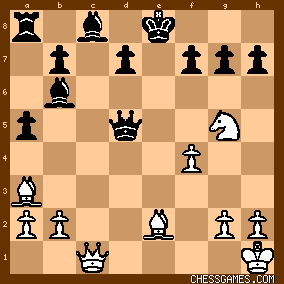
click for larger viewThe winning line is: (-2.58) (21 ply) 25...Qd4! 26.Bh5 g6 27.Bf3 Qe3 28.Qd1 Qxf4. Also, inadequate for White is: 25...Qd4! 26.Qe1 Qe3 27.Qd1 d5, or 25...Qd4! 26.Bb5 Qe3 27.Qb1 Qxf4. Instead of playing 25...Qd4!, Gunsberg played the fatal 25...f6??. After 26.Bh5+ g6 27.Qe1+ Kd8 28.Bf3, he could no longer defend his position. If he played 28...Qd3, White wins by 29.Nf7+ Kc7 30.Qc3+. After 25...f6?? 26.Bh5+, if Black plays 26...Kd8, White wins by 27.Nf7+ Ke8 28.Qe1 Qe6 29.Ng5+ g6 30.Nxe6. A very interesting and entertaining game. The missed winning chances are instructive. |
|
Jun-27-20
 | | KEG: Remarkably enough, Marco and Gunsberg--though both veteran--had only played each other once (a draw at Hastings 1895) before this encounter. Including this game, they ultimately squared off seven times, Marco finishing with four wins against one loss and two draws. The instant game--played in the penultimate round at Monte Carlo--occurred when Marco was long since out of contention for a prize, and Gunsberg had only a slim chance at a minor prize. Nonetheless, the game was exciting, even if filled with tactical errors. Marco's early Rook sacrifice and decision to castle into a discovered check made this game the thrilling contest it wound up being. <Pawn and Two> back in 2010 did an excellent job of identifying the key moments of this game. His analysis is so good I would not have bothered commenting had I not previously resolved to cover all of the games at this tournament. 1. e4 e5
2. Nf3 Nc6
3. Bb5 Nf6
The Berlin Defense was very popular at the time, before it went out of fashion only to be revived by Kramnik in his 2000 match against Kasparov. 4. Nc3
A sound but not very ambitious line.
4... Bc5
Lasker used it to play for a win in the final round at Cambridge Springs 1904 in his game against Janowski when he needed a win to tie Janowski for second place. 5. Nxe5 NxN
6. d4 Bd6
7. f4
"?"--(Tournament Book).
This looks best to me. Janowski played it in the above-mentioned game against Lasker. 7... Nc6
Lasker played 7...Ng6
"7...Nc6 had been analyzed into a drawish ending by Bardeleben." (Soltis) 8. e5 Bb4
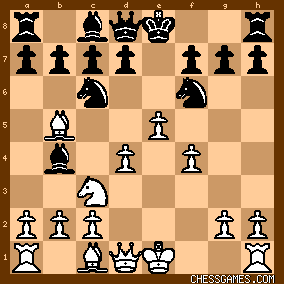
click for larger view9. exN
The Tournament Book stated that 9. d5 was "usual" in this position (as of 1901), but acknowledged that the text is preferable (as it is). 9... Qxf6

click for larger view10. d5?
Weak. 10. a3 would allow White to retain some edge. 10... Nd4
Hardly best. <Pawn and Two> says that Gunsberg should have preferred 10...Ne7. But White then is fully equal after 11. Bd2. Better, as noted in the Tournament Book [whose comments on this game <Pawn and Two>attributes to Hoffer though I can find nothing to support this attribution] was 10...BxN+ (11. bxB Qxc3+ 12. Bd2 Qc5 13. Qe2+Kd8 [White is fine after 13...Ne7 14. Rb1] and Black with his extra pawn is better situated. 11. Bd3
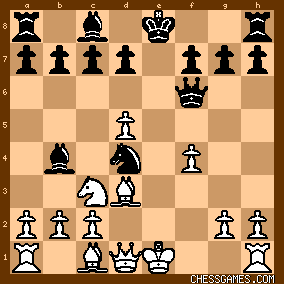
click for larger view11... Bc5?
"?"--(<Pawn and Two>) "11...Nf5 with approximately even chances." (<Pawn and Two>) Now, as will be seen, Black was probably lost.
12. Ne4 Qe7
12...Qh4+ 13. g3 was even worse.
After 12...Qe7, the following crucial position in the game was reached. 
click for larger view |
|
Jun-27-20
 | | KEG: Post II
Now Marco did something remarkable:
13. 0-0 !?
"Deliberately castling into a discovered check." (<chancho>) "A bold resolution in view of the discovered check. The exchange sacrifice is attractive and correct." The above notwithstanding, the correct move was found by: "13. Kd2." (<zanshin>) The situation was fully and correctly described by <Pawn and Two>: "White could have obtained a considerable advantage by playing 13. Kd2...13. 0-0 considerably reduced his advantage." The amazing position after the text was:

click for larger viewWhite still is better, but Gunsberg could have obtained some excellent counter-play. Instead, he decided to try to nab a Rook with: 13... Nxc2+?
"It would have been better to forego the temptation; but a Rook is a good price even for a bad position." (Tournament Book) As just about always here, the best assessment comes from <Pawn and Two>: "Gunsberg's best reply to 13. 0-0 was 13...Nb3+ (accord <zanshin>). After 13...Nb3+ Black would have been very much in the game; e.g., 14.Nf2 BxN+ 15. RxB NxB [but not 15...NxR?? 16. Re2] 16. RxN 0-0. After 13...Nxc2+, Marco was back in the driver's seat: 
click for larger viewJust look at that pathetic Black Bishop on c8 locked in by his own pawns on b7 and d7. Amazingly, this formation did not change through the end of the game. But Marco's winning edge vanished with his next move: 14. Kh1?
Once again, <Pawn and Two says it all>: "Instead of playing 14. Nf2 with strong winning chances, Marco erred with 14. Kh1? 14... NxR
15. Re1
Now, Marco would have to fight hard just to survive. 
click for larger viewHere, Gunsberg had to be careful. Clearly he had to get his King and Queen off the same soon to be open file. But 15...0-0?, as the Tournament Book pointed out, would lose to 16. Ng5! And 15...Kf8? would give White at least even chances after 16. Bd2 b6 17. Bc3 f6 18. Ng5. But Gunsberg played accurately here:
15... Kd8!
<Pawn and Two> assesses the game as "approximately equal" now. But in truth, Black with the extra material clearly had the better chances: 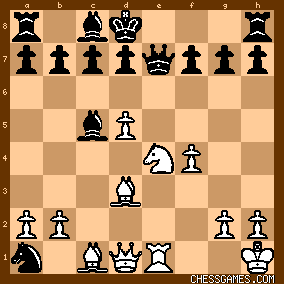
click for larger viewThe game, however, was destined to go through a number of twists and turns fro here before Marco would on top. |
|
Jun-28-20
 | | KEG: Post III
If you are going to sacrifice a Rook in the opening,you must be prepared to play vigorously and accurately. Marco was never known as an attacking player, so it is perhaps not shocking that his play from here was less than flawless, and gave Gunsberg definite winning chances. 16. Bd2?
"?"--(<Pawn and Two>) ""Instead of 16. d6 with a near equal [I would still favor Black with the extra material--KEG] position, Marco erred with 16. Bd2? giving the advantage to Black." (<Pawn and Two>) After 16. d6 play might have continued: 16...Bxd6 17. Ng5 [the only chance to justify the sacrificed material] Qf6 18. Bc4 [again the only chance for White to justify his play] Nc2 19. QxN Re8 with considerable pressure for his sacrifice of the exchange and two pawns. But after the wimpy 16. Bd2?, the position was:

click for larger viewNow Gunsberg had a chance to consolidate and have excellent chances to capitalize on his extra material. However, he blundered with: 16... Bd4?
"??"--(<Pawn and Two>) As Pawn and Two further notes, Gunsberg would have been well-situated with 16...f6! White would still have some compensation, so the position would not necessarily have been a win for Black, but White would have a tough time justifying his sacrifices. Also good for Black here is 16...Qf8. But after the text, Marco's attack suddenly gained speed with: 17. d6!
"!"--(Tournament Book)
"Marco [now] clearly winning." (<Pawn and Two>) Gunsberg's 16...Bd4? was so bad that Marco would also be winning after 17. Qa4. The text, however, was even stronger, and left the position as: 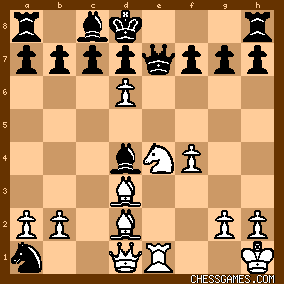
click for larger view17... cxd6
17. d6! must have been an awful move to face over the board. The text seems hopeless. But after looking at 17...Qf8 (Fritz) and 17...Qe6 (Stockfish), everything else looks just about as bad. As Bobby Fischer would say, Black is busted.
18. Bb4!
A killer move.

click for larger view18... Qe6?
A hopeless effort by Gunsberg. The only realistic hope was to try a Queen sacrifice with 18...Bc5 19. NxB QxR+ 20. BxQ dxN 21. QxN leaving Black with two Rooks and two pawns for Queen and Bishop. Still a win for White, but perhaps allowing some tricky play. After the text, Marco could have put Gunsberg out of his misery immediately, the position now being: 
click for larger viewIncredibly, and as I will discuss in my next post on this game, Marco from here lost his way, and first missed a quick win and then committed a blunder that left him lost by move 22 (though Gunsberg later blundered away what should have been a winning position and Marco ended up winning anyway). |
|
Jun-28-20
 | | KEG: Post IV
19. QxN?
"The sharpest continuation was 19. Nxd6 and Bc4." (Tournament Book) "Fritz confirms that 19. Nxd6 was White's strongest continuation." (<Pawn and Two>) 19. Nxd6 was indeed best play and would have left Gunsberg no real chances: e.g., 19. Nxd6 Qf6 (best) 20. Qh5 Rf8 (20...g6 gets crushed by 21. Qa5+ b6 22. Qd5) 21. Nb5 a6 (if 21...Re8 22. RxR+ KxR 23. Qxh7 d6 24. Nxd6+ Kd7 25. Bb5+ Kd8 26. Qh8+ Kc7 27. Ne8+) 22. NxB QxN 23. Bc5 Qf6 24. BxR b6 25. Qxh7 Kc7 26. Bxg7 Qd8 27. Be5+ d6 28. Qxf7+ Kb8 29. Bf6). Also strong was 19. f5, e.g., 19...Qxf5 20. Nxd6 Qf2 21. Rf1 Qxb2 22. Nxf7+ Kc7 23. Bd6+ Kb6 24. Qa4 a6 25. Rb1 QxR+ 26. BxQ Bc5 27. BxB+ KxB 28. Qa3+ etc. After Marco's 19. QxN, White was still probably winning, but the outcome was no not entirely clear: 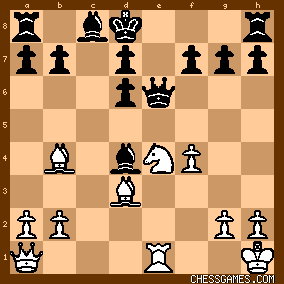
click for larger view19... a5
This was Black's best chance, but--as <Pawn and Two> correctly notes, White still was "winning." 20. Bxd6
20. Nxd6 was arguably better, but <Pawn and Two> is correct that the text was also sufficient. 20... Re8
21. Qc1 Bb6

click for larger view22. Re2?
"Instead of playing 22. Bc4! Marco made a very serious error playing 22. Re2??. After 22. Re2??, Gunsberg obtained a winning position. (<Pawn and Two>) <Pawn and Two> was once again correct on all points. 22. Bc4 would indeed have won: e.g., 22...QxN [Black has nothing better than to give up his Queen] 23. RxQ RxR 24. Bxf7 and Black, though having two Rooks for White's Queen, is too bottled up to offer any real resistance. Marco could also have won here with 22. f5! Qxf5 (22...Qh6 was arguably better, but still hopeless) 23. Rf1 Qd5 24.Qg5+ QxQ 25. NxQ Re7 [what else??] 26. Nxf7+ Ke8 27. Ne5 Ra6 28. Bxh7 Bf2 29. BxR KxB 30. RxB leaving White a piece to the good. But after the text, Marco was lost:
22... Qd5!
Forced, but a winning move.
23. Ng5
White's best chance.
23... RxR
24. BxR

click for larger view24... Ke8
"!"--(<Pawn and Two>) While <Pawn and Two> got this right, the Tournament Book was out to lunch here: "Black defended himself very well in this difficult position, but here, pressed for time, he overlooked the right move: 24...f6. White would have difficulty in maintaining the attack then." (Tournament Book) Nonsense. The text should win. By contrast, 24...f6? should result in a draw: 25. f5! g6 26. Bf3! Qd4 (or 26...Qxf5 27. Qe1 Be3 [forced] 28. Nx7+ [the Bishop cannot be taken immediately because of the resulting back-rank mate] Ke8 29.QxB+ Qe6 30. Be4 Ra6! 31. Bc5 d6 32. Nxd6+ RxN 33. BxR f5! 34. Qc3 fxB with a likely draw because of Bishops of opposite colors) 27. fxg6! hxg6 28. Be4! Qg1+ 29. QxQ BxQ 30. Nf7+ Ke8 31. Bxg6! Bf2 32. Nh6+ Kd8 33. Nf7+ and draw by perpetual check. After the text, however, Gunsberg should have won. 25. Ba3
Best.
The position was now:

click for larger view |
|
Jun-28-20
 | | KEG: Post V
Here, Gunsberg blundered away the game:
25... f6?
As <Pawn and Two> has noted, Gunsberg could have won here with 25...Qd4! If then 26. Bh5+ (the move given by <Pawn and Two>, Black wins after 26...g6 27. Bf3 [27. Be2 is no better--KEG] Qe3 [27...d5 is more immediately decisive than the move suggested by <Pawn and Two>] 28. Qd1 and now Black can still win with 28...Qxf4, but not with 28...d5 (the move given by <Pawn and Two>) which allows White to survive after 29. Bxd5 Bc5 30. Bxf7+ Ke7 31. BxB+ QxB 32. Qe1+ Kd8 33/ Nxh7 where, with two pawns for the exchange and better placed pieces, White would have good chances of obtaining at least a draw. 26. Bb5 and 26. Nxh7 would be better chances for White than 26. Bh5, but I can't find a way to avoid loss for White even after those moves. One thing is for sure, after 26...f6?, Gunsberg was lost: 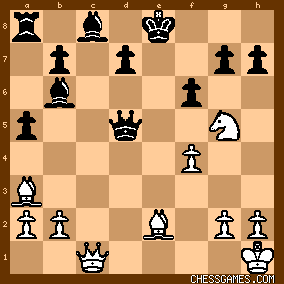
click for larger viewMarco now finished nicely:
26. Bh5+! g6
As <Pawn and Two> has shown, Black gets crushed after 26...Kd8 (27. Nf7+ Ke8 28. Qe1+ Qe6 29. Ng5+ g6 30. NxQ). 27. Qe1+
"!"--(Tournament Book)
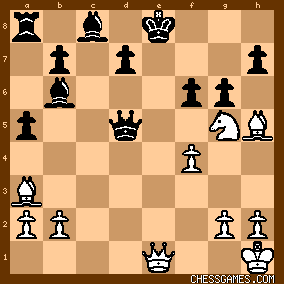
click for larger view27... Kd8
28. Bf3
"!"--(Tournament Book)
28... Qd4
28...Qc5 might have prolonged the game, but would not have changed the outcome. After 28...Qd4, the position was:
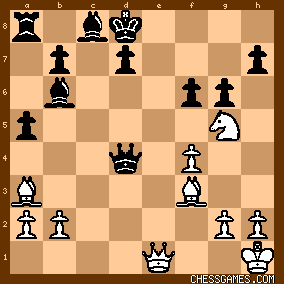
click for larger viewNote Black's pathetic c8 Bishop, still locked on its original square by the Black pawns on b7 and d7. 29. Qe7+ Ke7
30. Ne6+
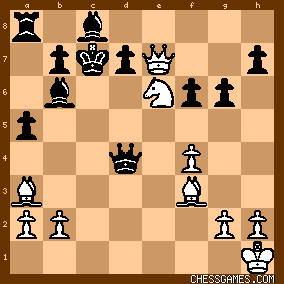
click for larger viewBlack now loses first his Queen and then his King. 1-0 |
|
|
|
|





